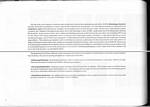|
|
 |
 |
AUSCHWITZ:
Technique
and Operation
of
the Gas Chambers © | |
|
| |
 |
Back |
 |
Contents |
Page 22 |
 |
Home
Page |
Forward |
 |
| |
Part One of the work
comprises a systematic and in-depth study, insofar as the remaining
documents allow, of all the delousing gas chambers and other
disinfestation installations, in order to describe their
characteristics and operation. The aim of this presentation is to
demonstrate the rudimentary nature of the delousing gas
chambers and the gradual increase in their area and volume. We pass
from a fully planned complex of nineteen 10m³ chambers of the
Degesch type built by Boos in the Stammlager to those of 490m³
rapidly improvised by the Bauleitung in Birkenau BW 5a and 5b. As
the existence of these last is confirmed by Bauleitung drawings and
the fact that they can still be seen in buildings BW 5a and 5b,
their bluish walls bearing indisputable witness to their use with a
hydrocyanic product, Zyklon-B, it is thus proven that the use of two
underground morgues, each of 525m³, the Leichenkeller I of
Krematorien II and III, as homicidal gas chambers presents no
physical or technical impossibilities. The execution gas chambers in
the United States are extremely sophisticated, but their design must
be seen in the context of a highly technological country in
peacetime, and they are presumably intended to be humane, which was
not a prime concern of the SS. The presence of the delousing gas
chambers also establishes that Zyklon-B, delivered by Tesch and
Stabenow and by Degesch, was by no means destined solely for
extermination purposes, but by far the greatest part of it was used
for "Schädlingsbekämpfung" or pest control, both in these chambers
and also in situ in the prisoners' accommodation blocks.
The
Bauleitung SS used three different words to distinguish clearly
between the methods of "disinfestation" used in their sanitary
buildings. Each word has a very precise meaning and applies to a
single type of procedure: |
| |
|
| • |
"Entlausung / Delousing"
: the delousing of prisoners' effects by hydrocyanic acid (Zyklon-B)
gassing in a closed space, relatively air-tight, fitted with
mechanical ventilation and called a "delousing gas chamber" ;
|
| |
|
| • |
"Entwesung /
Disinfestation": destruction of pests (essentially lice) by dry
heat in hot air chambers. This technique makes it possible to
destroy the majority of pathogenic germs (and harmful insects),
without going as far as the stage of disinfection (total destruction
of pathogenic germs) nor as far as sterilization (destruction of all
micro-organisms, pathogenic or not); |
| |
|
| • |
"Desinfektion /
disinfection": the complete destruction of parasites and
pathogenic micro-organisms in prisoners’ effects using steam under
pressure in autoclaves (very close to sterilization, but less
complete). | |
AUSCHWITZ:
Technique
and operation
of the gas chambers
Jean-Claude Pressac
© 1989, The
Beate Klarsfeld Foundation |
 |
Back |
Page 22 |
Forward |
 |
|

